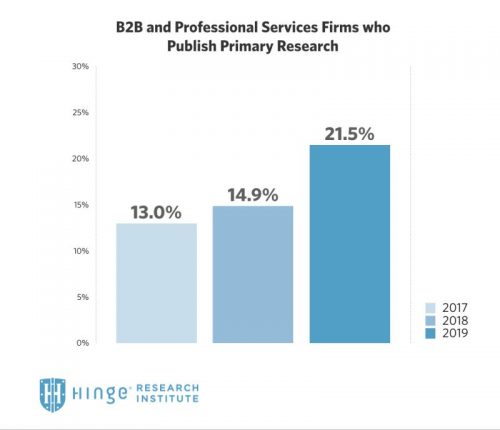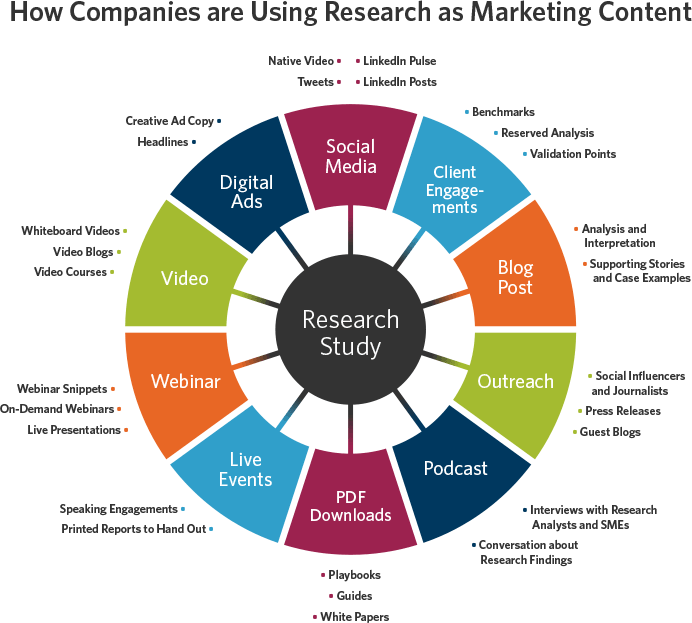Written by: John Tyreman
“How can I use research as marketing content?”
I’m glad you asked.
Today, about 1 in 5 B2B companies are publishing primary research and using it to reach new audiences, generate leads, and as validation for their services. That figure has risen over the past few years (see the image below)

Wait… only one in five? Yup. With so few companies taking advantage, primary research can be the secret weapon in your content strategy.
But you have to make sure it’s distributed effectively.
Researching an issue or topic important to your target buyers gives you “seed” content to distribute on a variety of channels and platforms (see the image below). When used strategically, one research report can fuel an entire year’s worth of marketing campaigns.

Come on down and spin the wheel! Here are 27 different content distribution ideas to promote your primary research.
Social Media
Native Video — social media algorithms (especially LinkedIn’s) love native video. By uploading video focused on one or two key research findings, it creates content unique to that social platform.
Tweets — I love Twitter because it forces marketers to refine messages and get their point across in 280 characters. Research gives marketers valuable content to share and distribute. 20 statistics can easily turn into 20 scheduled Tweets.
LinkedIn Pulse — Pulse articles are a great way to blog if your company doesn’t have one. This kind of content has a longer shelf-life than LinkedIn posts, and they show up as clickable links on your LinkedIn profile. Pulse articles can be used to post opinions or analysis of key research findings.
LinkedIn Posts — Like tweets, LinkedIn posts are unique to LinkedIn. But unlike Twitter, you have 1,300 characters to work with, giving you much more breathing room to write about each research statistic you choose to profile. Exhale!
Digital Advertisements
Creative Ad Copy — Calling Don Draper. When running visual advertisements like banner ads or ads on social, you could incorporate a research statistic into the creative. Just because it’s a statistic doesn’t mean it has to be dull…
Headlines — Using Statistics in Headlines Give you a 99% Better CTR… Ok, I made that stat up. But if you’re running PPC or other text-based ads, you could leverage research statistics to make your headlines jump out.
Video
Whiteboard videos — So you wanna be Rand Fishkin, huh? Whiteboard videos have a presenter explaining a topic, using a white board and marker to illustrate their point. Research can provide good content for presenters to illustrate or as validation for their main point.
Video blogs — Grab that selfie stick and record your research-based ramblings right to your cell phone. This raw style of video has seen success in some industries like marketing and consulting.
Video courses — E-learning is becoming a popular way for business owners to learn new skils and for enterprise organizations to train their staff on specific topic areas. By incorporating research into your video courses, it adds credibility to your lesson. Class dismissed!
Webinars
Live webinar presentations — Webinars and primary research go together like peanut butter and jelly… or pineapple and pizza (yum). If you conducted the research, host a webinar to distribute the results with your audience. If you license research, you could co-present with an analyst from the publishing organization.
On-demand webinars — Webinar binge and chill? Take the live webinar you presented in and offer it on-demand to your audience. This is a great way to build up an arsenal of valuable content that you can use to nurture leads and allow web visitors to find organically.
Webinar snippets — Take the on-demand webinar video file you have and isolate 1-3 minute clips to be promoted on social media, web pages, email and more. This is great fodder for social media, targeted email campaigns and specific web pages.
Live Events
Speaking engagements — Need a unique talk track? Talk about your primary research! Need I say more?
Printed reports to hand out — You download a digital research report, and then chances are it gets lost on your desktop or your downloads folder. Instead, have your report really stand out. Print copies of your research report, spiral bind it together, and hand them out to target accounts at live events. (BONUS — mail them to prospects with a handwritten note)
Contact us to learn more about using research as content
PDF Downloads
Playbooks — 2-minutes to go in the fourth quarter… What plays are you going to use to drive the ball downfield and win the game? Let’s hope those plays are founded in primary research… Playbooks are an effective tool, especially in Account Based Marketing (ABM) strategies. These are great ways to distribute research-based content internally.
How-to Guides — If your clients wanted to DIY the services they’re using you for, how would they do it? Here you can use primary research to illustrate why your process is effective, or leverage aggregate client results to demonstrate success.
Technical White Papers — By using primary research to help describe how a technology, product or service addresses a particular buyer challenge, you can reinforce your credibility and expertise on the subject.
Podcasts
Interviews with research analysts — If you co branded a research study with another organization, you could interview one of their analysts on your podcast. This is a great way to add validity to the research, and best of all? You don’t run the risk of being seen as self-promotional.
Conversations about research findings — Our latest research suggests less than 13% of B2B and professional services firms have a podcast. If you don’t have one, that’s OK. Pitch your research as a topic to other podcasts and go on their shows as guests. Tailor your conversation and how you frame the research to resonate with that particular audience.
Outreach
Press releases — This is a tried and true way of promoting a research study. Sending out a press release about your research gives journalists an opportunity to pick up stats and use them in their articles, giving your research the chance of reaching far and wide.
Guest blogs — Pitch a topic supported by your research to external publications that overlap with your target audience. This is another great way of increasing the visibility of your primary research and expertise.
Influencers & journalists — Influencer marketing has taken over B2C, and there have been noted success stories in B2B. If you can get a notable Visible Expert within a given industry to start talking about your research, it adds credibility and boosts visibility. …And sorry, pet animal accounts don’t count as influencers.
Blog Posts
Analysis and interpretation — You may need to write up the formal research report one way, but blogging is a great way to add analysis in your own voice about the primary research study. This adds character and depth to the narrative around the research.
Supporting stories and case examples — Everyone loves a good story. That’s probably why storytelling has become a hot topic in marketing lately. But when you take a good story and add compelling empirical evidence? That’s a marketing move that packs a one-two punch.
Client Engagements
Benchmarks — So… how do I stack up against my competitors? Some research can act as benchmarks to which you can compare your clients. This is one way you can distribute research-based content to add value to your client engagements.
Reserved analysis — You don’t have to publish all of the results. Another way to add value to client engagements is to reserve some of your analysis to share exclusively with your clients. VIP!
Validation points — If you are recommending a specific course of action to your clients, research can be a good way to validate your approach. This is what you should do, and here’s research
Summary
If you are going to publish primary research, make sure you have a content distribution strategy that ensures you get maximum reach and visibility. Without good distribution, even the most insightful research study will collect digital dust sitting around only on your website.
Related: 10 Ways to Measure M&A Success

